Discovering Tutankhamun in colour
Harry Burton's photographs taken during the excavation of the Tomb of Tutankhamun reconstructed in colour by Dynamichrome (2015) and Composite Films (2020)
Harry Burton's photographs capturing Tutankhamun's tomb at the moment of its discovery have enthralled the world for generations, enabling the viewer to witness the 'Wonderful Things' the discoverers of the tomb, Howard Carter and Lord Carnarvon, were fortunate to experience first-hand. Burton's iconic black & white photographs have illustrated the imagination of millions for almost a century. A selection of the original negatives and photographs, housed in the archive of the Griffith Institute, University of Oxford, has been digitally colourised:- The first set of colourised images were produced by Dynamichrome on behalf
of SC Exhibitions. These images were first featured
in the exhibition 'The Discovery of King Tut' in New York, November 2015 to May 2016.
- The second set were commissioned by Blakeway Productions and colourised
by Composite Films. These images were first used in the BBC Four/Nat Geo/France 5
documentary 'Tutankhamun in Colour', first broadcast in 2020.
- The third set were produced again by Dynamichrome on behalf of SC Exhibitions. These images first appeared in the exhibition 'Tutankhamun: His Tomb and His Treasures' in Brussels, July 2022 to January 2023.
Please note that the Griffith Institute owns the copyright for all the black & white scans created from the original Harry Burton negatives and the colourised versions. High-resolution scans are available—address email enquiries to griffith.institute@ames.ox.ac.uk. For further details on image prices and licenses, see here.
All images to be acknowledged as © Griffith Institute, University of Oxford.
All © Griffith Institute, University of Oxford (colourised by Dynamichrome, 2015)
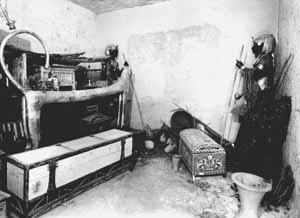
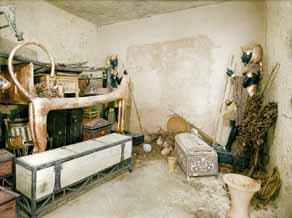
December 1922, Tutankhamun's Tomb | View of the northern wall of the Antechamber showing the sentinel statues (Carter nos. 22 & 29) guarding the sealed doorway leading to the King's Burial Chamber | Burton photograph 0007 © Griffith Institute, University of Oxford (colourised by Dynamichrome)

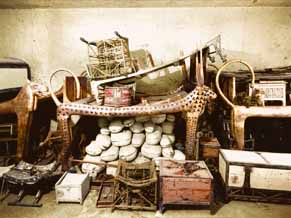
December 1922, Tutankhamun's Tomb | Objects, including the cow-headed couch (Carter no. 73) and boxes containing joints of meat (Carter nos. 62a to 62vv) piled up against the west wall of the Antechamber. | Burton photograph 0009 © Griffith Institute, University of Oxford (colourised by Dynamichrome)
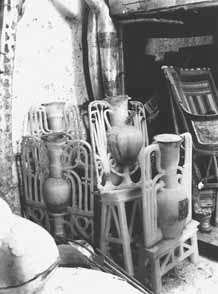
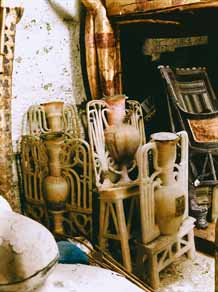
December 1922, Tutankhamun's Tomb | Sealed alabaster 'unguent' vases (Carter nos. 57, 58, 60 and 61) between the cow-headed (Carter no. 73) and lion (Carter no. 35) couches against the west wall of the Antechamber. | Burton photograph 0010 © Griffith Institute, University of Oxford (colourised by Dynamichrome)
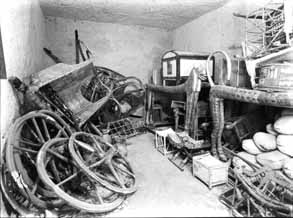
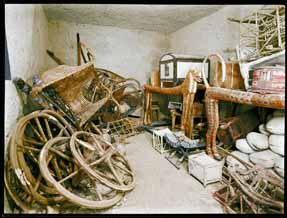
December 1922, Tutankhamun's Tomb | Disassembled chariots and the 'Toeris' (Ammut) (Carter no. 137) and cow-headed couches (Carter no. 73) at the southern end of the Antechamber. | Burton photograph 0012 © Griffith Institute, University of Oxford (colourised by Dynamichrome)
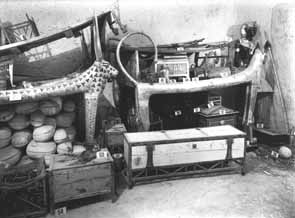
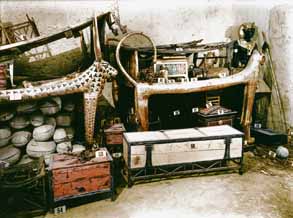
December 1922, Tutankhamun's Tomb | The rectangular white box (Carter no. 50), in front of the lion couch (Carter no. 35) in the Antechamber, contained, amongst other items, linen garments (shirts, shawls and loin cloths), 18 sticks, 69 arrows and a trumpet. | Burton photograph 0019 © Griffith Institute, University of Oxford (colourised by Dynamichrome)
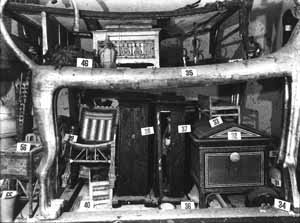
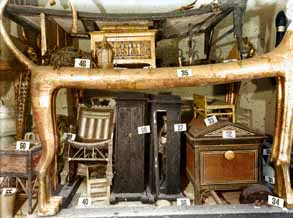
December 1922, Tutankhamun's Tomb | Objects stacked under the lion couch (Carter no. 35) against the west wall of the Antechamber included an ivory and ebony chest (Carter no. 32), black 'shrine-shaped boxes' (Carter nos. 37 and 38) and a child's chair made of ebony (Carter no. 39). | Burton photograph 0020 © Griffith Institute, University of Oxford (colourised by Dynamichrome)
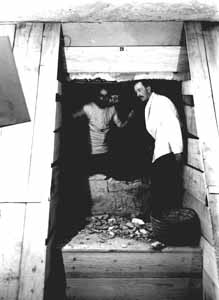
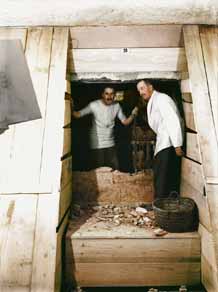
16th February 1923, Tutankhamun's Tomb | One of only two images showing Howard Carter (on the left) and Lord Carnarvon together in the tomb; they stand in the partially dismantled doorway (Carter no. 28) between the Antechamber and the Burial Chamber. Lord Carnarvon died less than two months after this photograph was taken. | Burton photograph 0291 © Griffith Institute, University of Oxford (colourised by Dynamichrome)
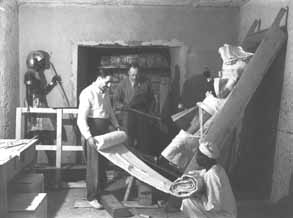
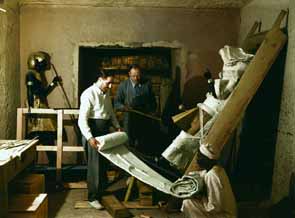
29th November 1923, Tutankhamun's Tomb | Howard Carter (on the left) working with his friend and colleague Arthur Callender on wrapping one of two sentinel statues of Tutankhamun (Carter no. 22) found in the Antechamber, before their removal to the 'laboratory' set up in the tomb of Sethos II (KV 15). These statues had been placed either side of the sealed entrance to the Burial Chamber. | Burton photograph 0491 © Griffith Institute, University of Oxford (colourised by Dynamichrome)
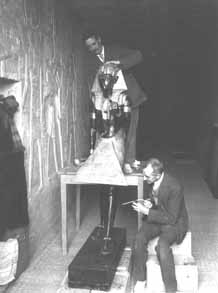
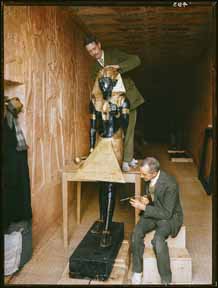
January 1924, Sethos II's Tomb ('laboratory') | Arthur Mace (standing) and Alfred Lucas (sitting) working inside the makeshift 'laboratory' (set up in KV 15, the tomb of Sethos II) on the conservation of one of the two sentinel statues from the Antechamber (Carter no. 22). The statue shows the King wearing the nemes headdress, kilt and sandals, and carrying a mace and a staff. | Burton photograph 0493 © Griffith Institute, University of Oxford (colourised by Dynamichrome)
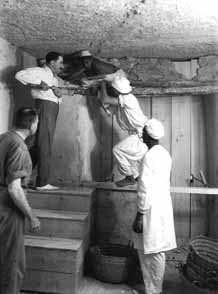
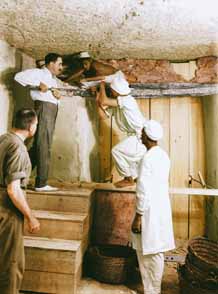
2nd December 1923, Tutankhamun's Tomb | Howard Carter (at the top of the stairs), Arthur Callender and Egyptian workmen removing the wall between the Antechamber and the Burial Chamber to enable the dismantling of the four golden shrines enclosing the sarcophagus. | Burton photograph 0509 © Griffith Institute, University of Oxford (colourised by Dynamichrome)
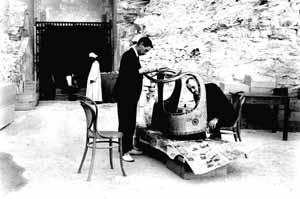
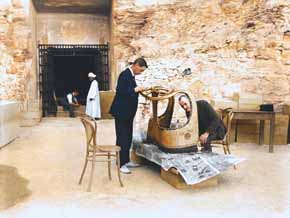
November/December 1923, Sethos II's Tomb ('laboratory') | Arthur Mace (left) and Alfred Lucas working outside the 'laboratory' set up in the tomb of Sethos II (KV 15), removing solidified paraffin wax droplets from one of the gilded chariots (Carter no. 120) found in the Antechamber. During the clearance of Tutankhamun's tomb, the excavation team's conservators used gallons of this wax, which was heated and then applied while liquid, to stabilise and protect objects, especially those with gilded and inlaid decoration. Once this final conservation task was complete, the team wrapped and crated each object, ready for its transport to the Egyptian Museum in Cairo. | Burton photograph 0517 © Griffith Institute, University of Oxford (colourised by Dynamichrome)
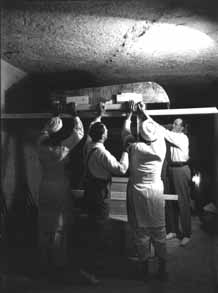
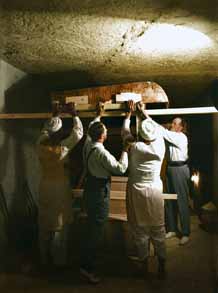
December 1923, Tutankhamun's Tomb | Howard Carter (centre), Arthur Callender and two Egyptian workmen lifting one roof section from the first, outermost shrine (Carter no. 207). With its double sloping roof, the shape of this shrine resembles that of a 'sed festival pavilion'; it was made of from twenty separate oak sections, held together by a variety of different joints. | Burton photograph 0605 © Griffith Institute, University of Oxford (colourised by Dynamichrome)
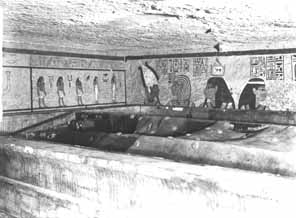
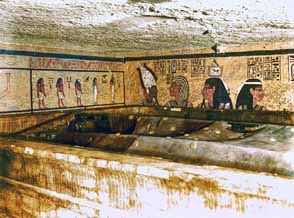
December 1923, Tutankhamun's Tomb | The linen pall, decorated with bronze 'rosettes' (Carter no. 209) inside the walls of the first (outermost) golden shrine (Carter no. 207) in the north west corner of the Burial Chamber. | Burton photograph 0616 © Griffith Institute, University of Oxford (colourised by Dynamichrome)
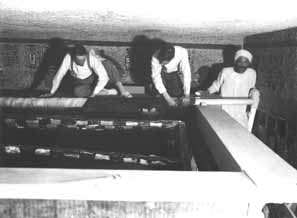
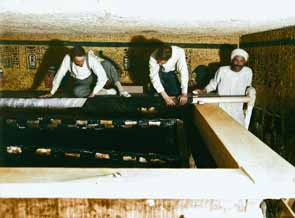
30th December 1923, Tutankhamun's Tomb | Howard Carter (left), Arthur Mace and an Egyptian workman standing on scaffolding, roll back the linen pall (Carter no. 209) which lay over a gilded, wooden frame (Carter no. 208) between the first (outermost) and second shrines. | Burton photograph 0619 © Griffith Institute, University of Oxford (colourised by Dynamichrome)
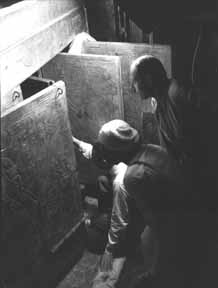
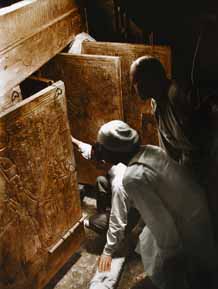
4th January 1923, Tutankhamun's Tomb | Howard Carter (kneeling), Arthur Callender and an Egyptian workman in the Burial Chamber, looking through the open doors of the four gilded shrines towards the quartzite sarcophagus. | Burton photograph 0643 © Griffith Institute, University of Oxford (colourised by Dynamichrome)
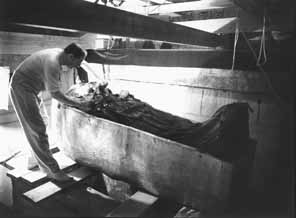
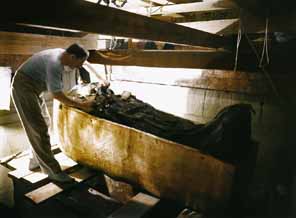
October 1925, Tutankhamun's Tomb | Howard Carter working on the lid of the second (middle) coffin, still nestled within the case of the first (outermost) coffin in the Burial Chamber. | Burton photograph 0720-2 © Griffith Institute, University of Oxford (colourised by Dynamichrome)
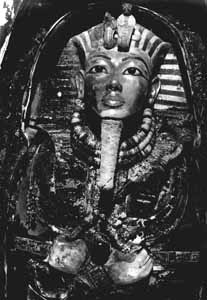
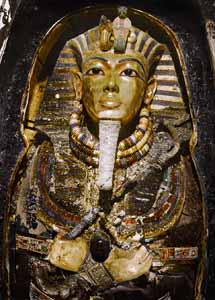
29th/30th October 1925, Tutankhamun's Tomb | The gold mask (Carter no. 256a) in situ on the mummy of the King, still inside the third (innermost) solid gold coffin (Carter no. 255). | Burton photograph 0744 © Griffith Institute, University of Oxford (colourised by Dynamichrome)
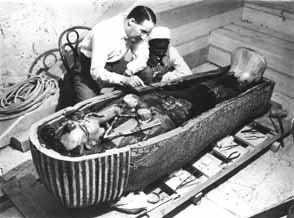
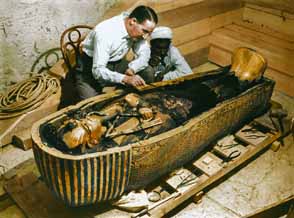
29th/30th October 1925, Tutankhamun's Tomb | Carter and an Egyptian workman examine the third (innermost) coffin (Carter no. 255) made of solid gold, inside the case of the second coffin. (Carter no. 254). | Burton photograph 0770 © Griffith Institute, University of Oxford (colourised by Dynamichrome)
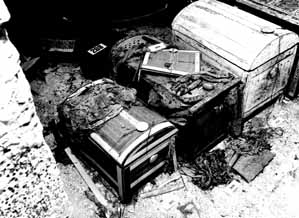
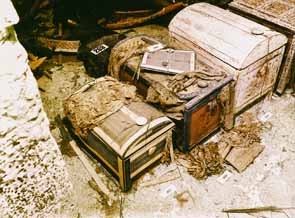
October 1926, Tutankhamun's Tomb | Three wooden chests (the middle one in the shape of a cartouche) on the floor of the Treasury (Carter nos. 267, 269 and 270). Amongst other items these contained earrings, sandals and a wax model of a heron. | Burton photograph 1091 © Griffith Institute, University of Oxford (colourised by Dynamichrome)
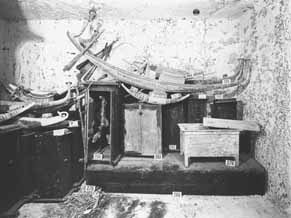
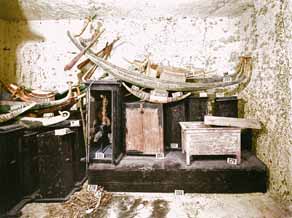
November 1926, Tutankhamun's Tomb | Objects, including numerous model boats (Carter nos. 284 to 287), stacked against the southern wall of the Treasury. | Burton photograph 1097b © Griffith Institute, University of Oxford (colourised by Dynamichrome)
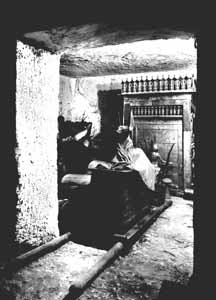
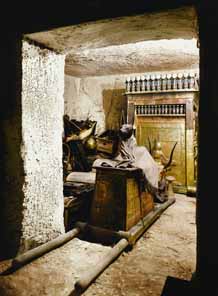
October 1926, Tutankhamun's Tomb | The Anubis shrine (Carter no. 261) on the threshold of the Treasury viewed from the Burial Chamber. The figure of Anubis was covered with a linen shirt inscribed with the cartouche of Akhenaten. | Burton photograph 1169 © Griffith Institute, University of Oxford (colourised by Dynamichrome)
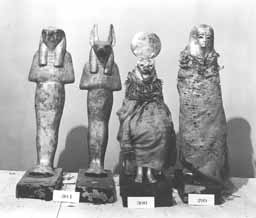
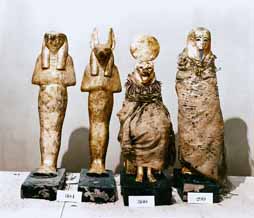
Winter 1926, Tutankhamun's Tomb | Howard Carter found twenty-nine small statues of deities in Tutankhamun's tomb, and four of them are featured here, from left to right, falcon-headed Qebhsenuef (Carter no. 304a) and jackal-headed Duamutef (304b) both wearing tight-fitting garments, while the two figures, mostly hidden beneath linen 'cloaks', are the goddess Sekhmet (300a) with a sun disk on her head, and to her right is Geb (299a) wearing a tightly plaited beard. Many statues and other objects in the tomb had linen covers and wrappings, some adorned with floral collars and garlands, like the cornflower and olive-leaf example fastened around Sekhmet's neck. | Burton photograph 1665 © Griffith Institute, University of Oxford (colourised by Dynamichrome)
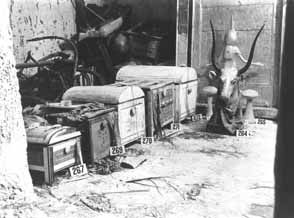
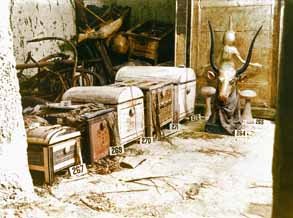
October 1926, Tutankhamun's Tomb | A line of chests down the centre of the Treasury, ending with the canopic chest (Carter no. 266) which housed the king's linen-wrapped stomach, intestines, liver and lungs in miniature gold coffins, inside an alabaster canopic box. | Burton photograph 1961 © Griffith Institute, University of Oxford (colourised by Dynamichrome)
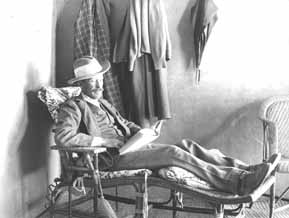
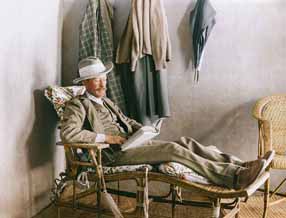
Herbert George Edward Stanhope Molyneux, 5th Earl of Carnarvon, reading on the verandah of 'Castle Carter', Carter's house at Elwat el-Dibbân on the Theban West Bank. | Burton photograph kv93 © Griffith Institute, University of Oxford (colourised by Dynamichrome)
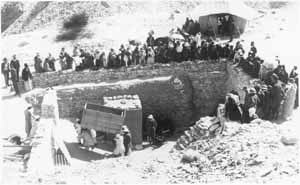
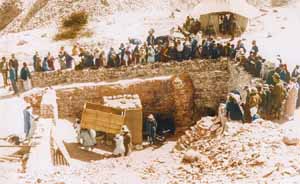
1923, Thebes | Tourists crowd around the entrance to the tomb to watch a large object, possibly a couch from the Antechamber, being removed from Tutankhamun's tomb, on its way to the workroom (tomb KV 15, of Sethos II). | Photograph TAA ii.4.10 (photographer not known) © Griffith Institute, University of Oxford (colourised by Dynamichrome)
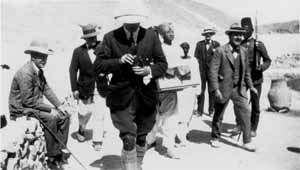
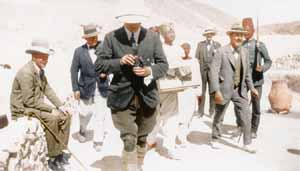
1923, Thebes, | Howard Carter accompanies the wooden portrait figure of Tutankhamun (the so-called mannequin, Carter no. 116, of uncertain purpose) on its way to the workroom (tomb KV 15, of Sethos II). Sitting on the wall on the left is Lord Carnarvon; behind him walks Arthur Weigall, a former Antiquities Service Inspector. | Photograph TAA ii.4.38 (photographer not known) © Griffith Institute, University of Oxford (colourised by Dynamichrome)
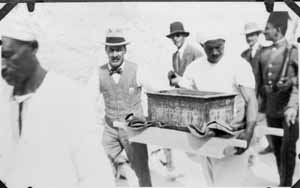
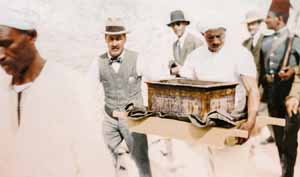
1923, Thebes | Howard Carter escorting an ornamental gilt and inlaid casket (no. 44) to the workroom (tomb KV 15, of Sethos II). Carter thought the contents of this box had been 'gathered hastily together after the robbery was discovered and thrown carelessly into the box'. They included pieces of gold openwork, two adzes, a glove, a faience collar and a leopard skin robe. | Photograph TAA.ii.6.17 (photographer not known) © Griffith Institute, University of Oxford (colourised by Dynamichrome)
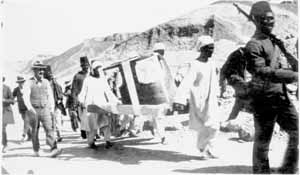
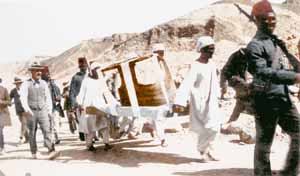
1923, Thebes | Howard Carter (on the left) accompanies the body of one of Tutankhamun's chariots (no. 122) to the workroom (KV 15, of Sethos II). Made of wood, with rawhide tyres, this chariot was highly decorated with gold, coloured glass and stone inlay, and probably used on ceremonial occasions. | Photograph TAA ii.6.20 (photographer not known) © Griffith Institute, University of Oxford (colourised by Dynamichrome)
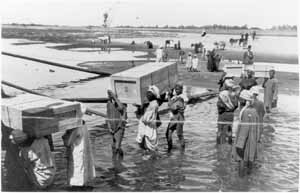
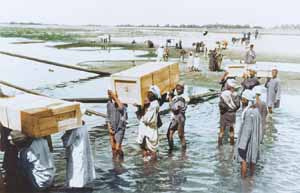
1923, Thebes | Objects from the tomb were packed into wooden crates and transported from the workroom (tomb KV 15, of Sethos II) to the banks of the Nile for transportation to Cairo by boat. Although a relatively short distance from the laboratory to the river, the journey by hand-pushed Decauville railway cars took 15 hours. | Photograph TAA ii.6.28 (photographer not known) © Griffith Institute, University of Oxford (colourised by Dynamichrome)
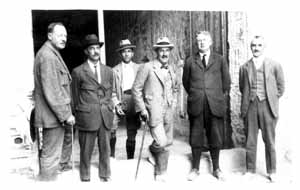
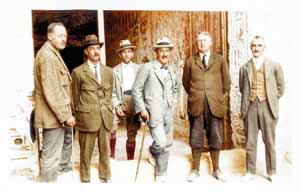
1923, Thebes | Standing outside tomb KV 6, of Ramesses IX, are (left to right) Arthur Callender, Arthur Mace, Harry Burton, Howard Carter, Alan Gardiner and Alfred Lucas. | Photograph TAA.ii.6.59 (photographer not known) © Griffith Institute, University of Oxford (colourised by Dynamichrome)
© Griffith Institute, University of Oxford (colourised by Composite Films, 2020)
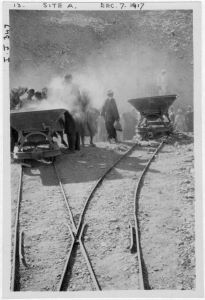
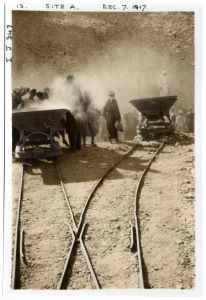
Carter-Carnarvon excavations in the Valley of the Kings: 1917
7 December 1917 | Valley of the Kings
Howard Carter's photograph records the removal of debris in the vicinity of the tomb of King Merneptah (KV 8), Valley of the Kings. Taken during the second excavation season, which took place between 1 December 1917 and 2 February 1918, this dig spot was some distance from the still-hidden entrance of Tutankhamun's tomb, some 170 metres away.
Carter MSS i.J.347 | © Griffith Institute, University of Oxford (colourised by Composite Films)
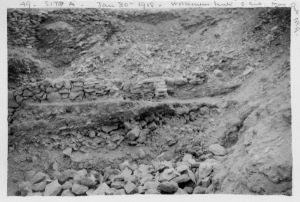
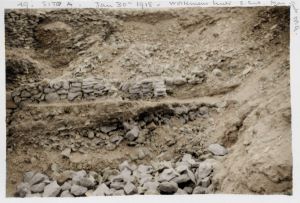
Carter-Carnarvon excavations in the Valley of the Kings: 1918
30 January 1918 | Valley of the Kings
Howard Carter's photograph documents the remains of ancient workers' huts near the tomb of King Ramesses VI (KV 9), Valley of the Kings. The entrance to Tutankhamun's tomb lay buried beneath several metres of limestone chippings created during the cutting of the nearby tomb of Ramesses VI, some 150 years after the burial of Tutankhamun. The workers then built their huts on top of the mined debris.
Carter MSS i.J.331 | © Griffith Institute, University of Oxford (colourised by Composite Films)
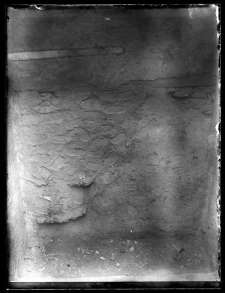
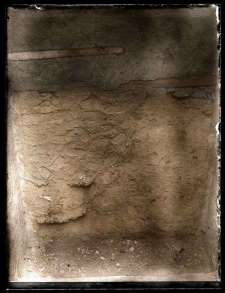
The sealed outer doorway of Tutankhamun's tomb
24 November 1922 | Tutankhamun's Tomb
The outer doorway of Tutankhamun's tomb, "with seals intact".
Burton photograph 0274 | © Griffith Institute, University of Oxford (colourised by Composite Films)
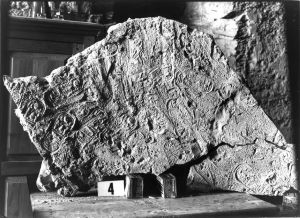
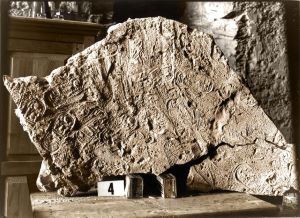
Fragment with seals from the outer doorway
1923 | Tutankhamun's Tomb
A section from the blocking sealing the tomb's outer doorway (Carter no. 4), its mud-plastered surface bears stamped impressions of the official necropolis seals and Tutankhamun's cartouche.
Burton photograph 0276 | © Griffith Institute, University of Oxford (colourised by Composite Films)
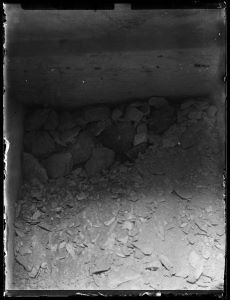
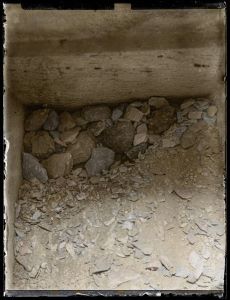
The ancient robbers' tunnel
25 November 1922 | Tutankhamun's Tomb
Howard Carter's photograph of the backfilled entrance corridor in Tutankhamun's tomb documents one of the ancient robbers' tunnels, seen here at the top left, evidence that the tomb had been entered and likely robbed in antiquity. The coarser dark flint and chert materials used by the necropolis priests to close the breach starkly contrast with the original fill of fine white limestone chippings.
Burton photograph 0004 | © Griffith Institute, University of Oxford (colourised by Composite Films)
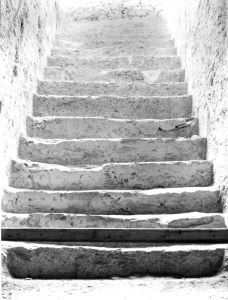
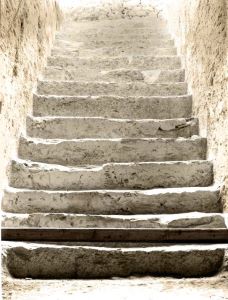
Sixteen steps
December 1922 or early 1923 | Tutankhamun's Tomb
This photograph was taken on the spot where the sealed entrance doorway was uncovered on 5th November 1922. Harry Burton's camera lens looks up the sixteen step staircase, towards the top step found on 4th November.
Burton photograph kv14 | © Griffith Institute, University of Oxford (colourised by Composite Films)
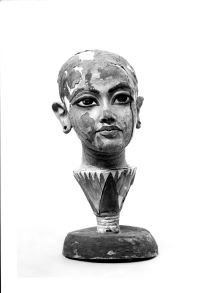
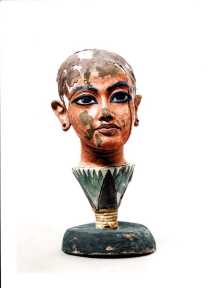
Head of Tutankhamun as the god Re
Probably between November 1923 and February 1924 | Tutankhamun's Tomb
A ritual figure portraying the head of Tutankhamun emerging from a lotus flower (Carter no. 8), reported to have been found in the Entrance corridor.
Burton photograph 0479a | © Griffith Institute, University of Oxford (colourised by Composite Films)
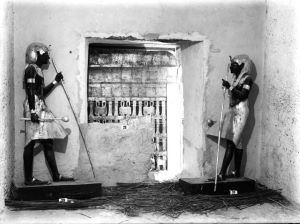
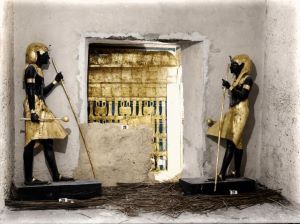
Tutankhamun's "guardian statues"
Probably February 1923 | Tutankhamun's Tomb
The two ka statues of Tutankhamun (Carter nos. 22 and 29), often referred to as the "guardian statues", stand sentinel on either side of the Burial chamber's doorway (Carter no. 28), with some of the door's blocking still in place.
Burton photograph p0292 | © Griffith Institute, University of Oxford (colourised by Composite Films)
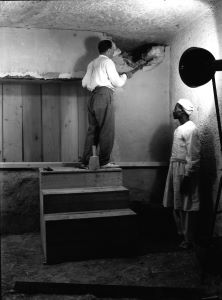
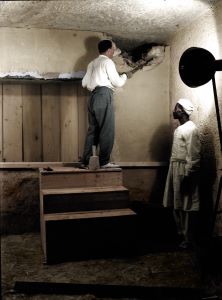
Removing the Burial chamber wall
1 December 1923 | Tutankhamun's Tomb
Howard Carter (on the left), assisted by an unidentified Egyptian team member, removing the partition wall to enable the dismantling of the four gilded shrines enclosing the sarcophagus. This wall, constructed from wood and masonry and covered on both sides by thick plaster, separated the Antechamber from the Burial chamber.
Burton photograph p0501 | © Griffith Institute, University of Oxford (colourised by Composite Films)
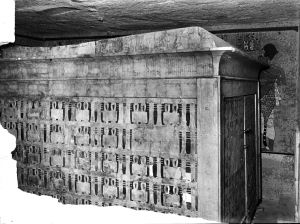
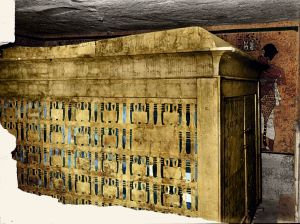
The room-sized shrine
16 or 17 February 1924 | Tutankhamun's Tomb
Harry Burton's photograph, taken from the Antechamber through the entrance into the Burial chamber, records Tutankhamun's blue and gold outermost burial shrine (Carter no. 207) that almost entirely filled the room.
Burton photograph p0603 | © Griffith Institute, University of Oxford (colourised by Composite Films)
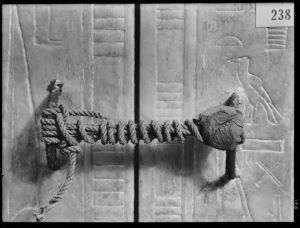
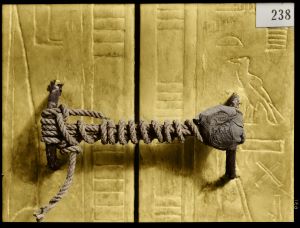
The unbroken seal
3 January 1924 | Tutankhamun's Tomb
Harry Burton's photograph records the intact necropolis seal and cord fastening (Carter no. 238a) on the third (of four) great gilded shrines surrounding Tutankhamun's sarcophagus in the Burial chamber. The unbroken seal confirmed that the King's body remained undisturbed, despite the tomb having been broken into and robbed several times in antiquity.
Burton photograph p0631 | © Griffith Institute, University of Oxford (colourised by Composite Films)
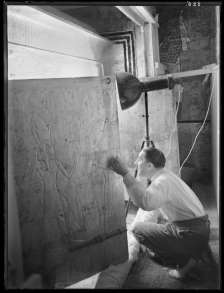
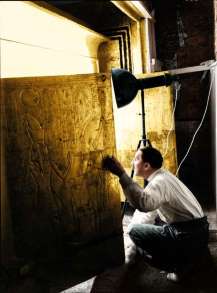
Howard Carter opening the burial shrine door
January 1924 | Tutankhamun's Tomb
Howard Carter opening the door of the second burial shrine (Carter no. 237), in Tutankhamun's Burial chamber.
Burton photograph 0626 | © Griffith Institute, University of Oxford (colourised by Composite Films)
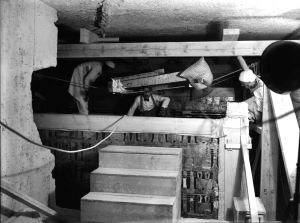
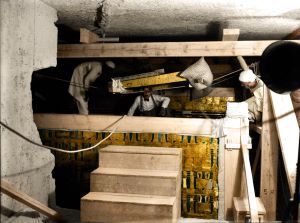
Lifting the gilded roof
January 1924 | Tutankhamun's Tomb
A precarious moment, captured by Harry Burton's camera, during the removal of a roof section from the first (outermost) shrine (Carter no. 207), showing Howard Carter crouching in the centre with two Egyptian team members securing the hoist. The 'flatpack' form of the four gilded burial shrines surrounding Tutankhamun's sarcophagus made it easier to install them in the small room in antiquity. Dismantling the shrines in the restricted space was one of the biggest challenges the team faced during the ten-year excavation.
Burton photograph 0634 | © Griffith Institute, University of Oxford (colourised by Composite Films)
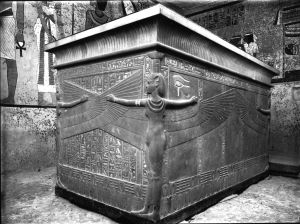
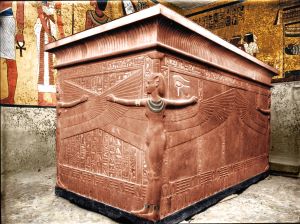
The sarcophagus
Mid-January 1933 | Tutankhamun's Tomb
A general view of Tutankhamun's sarcophagus (Carter no. 240) shows Isis, one of the four protective goddesses, carved in high relief on one of its corners. The goddesses' winged arms are stretched out to embrace the King. Harry Burton's photographs of the sarcophagus were the final excavation records made in the tomb.
Burton photograph 0646f | © Griffith Institute, University of Oxford (colourised by Composite Films)
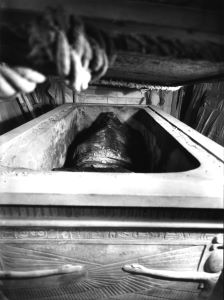
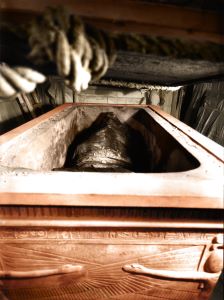
A shrouded figure inside the sarcophagus
12 February 1924 | Tutankhamun's Tomb
The first view inside the interior of Tutankhamun's quartzite sarcophagus (Carter no. 240) reveals a dark shrouded figure within. Harry Burton took this documentary photograph shortly after the sarcophagus lid had been lifted and removed. After completing this documentation stage, Howard Carter rolled down the linen covering to expose the King's outer anthropoid coffin (Carter no. 253).
Burton photograph 0648 | © Griffith Institute, University of Oxford (colourised by Composite Films)
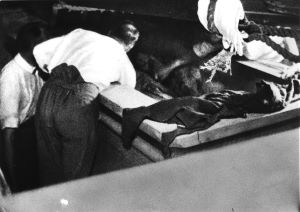
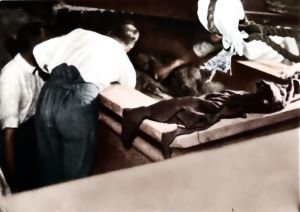
Removing the shroud
12 February 1924 | Tutankhamun's Tomb
This photograph was probably taken moments after removing part of the shroud covering Tutankhamun's outer anthropoid coffin (Carter no. 253). The cloth piled at the end of the sarcophagus is likely part of the coffin's linen covering. Although the photographer has not captured the faces of the three team members, tentative identifications can be assigned using Arthur Mace's journal entry for the event. On the left, the south side of the sarcophagus, with his back to the camera, stands Arthur Callendar, whose elbow obscures the face of Howard Carter. On the right (north) side, with his outstretched arm and hand touching the coffin, is Mace.
Burton photograph 0649a | © Griffith Institute, University of Oxford (colourised by Composite Films)
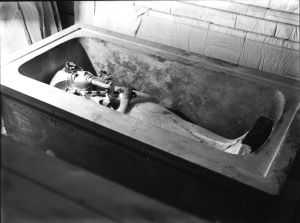
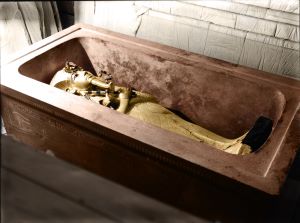
Tutankhamun's outer coffin in situ inside the sarcophagus
5 February 1925 | Tutankhamun's Tomb
Tutankhamun's outer coffin (Carter no. 253), as found, inside the sarcophagus (Carter no. 240), in the King's Burial chamber.
Burton photograph 0705 | © Griffith Institute, University of Oxford (colourised by Composite Films)
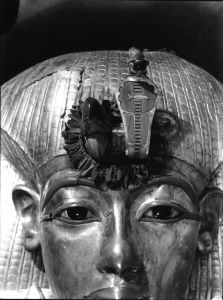
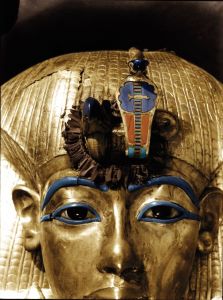
A tiny garland on the coffin's head
5 February 1925 | Tutankhamun's Tomb
A garland on the royal insignia of cobra and vulture on the forehead of Tutankhamun's outer coffin (Carter no. 253), as found in the King's Burial chamber.
Burton photograph 0709 | © Griffith Institute, University of Oxford (colourised by Composite Films)
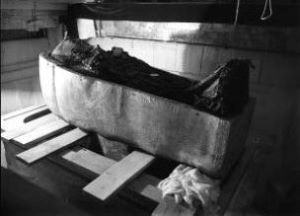
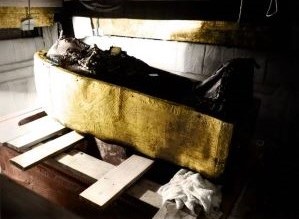
The veiled middle coffin
17 October 1925 | Tutankhamun's Tomb
Howard Carter's entry in his excavation journal mentions Harry Burton taking photographs of the lid of Tutankhamun's middle coffin (Carter no. 255), commenting "early this morning Burton completed successfully the photographic records of the second coffin, covered with its shroud and floral garlands, as it rested in situ in the shell of the outermost coffin".
Burton photograph 0717 | © Griffith Institute, University of Oxford (colourised by Composite Films)
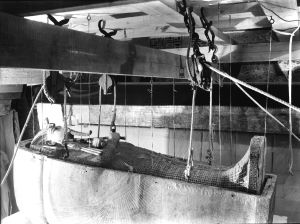
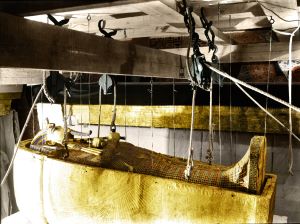
Removing Tutankhamun's middle coffin from the outer coffin
22 or 23 October 1925 | Tutankhamun's Tomb
Harry Burton's photograph records the equipment in place and ready for the delicate stage of removing the middle coffin from the lower part of the outer coffin. The team attached wire cables to the middle coffin, fixing these to the overhead scaffold, and then screwed strong metal eyelets into the top edge of the outer coffin's lower portion. After removing the planks laid on top of the sarcophagus beneath the coffins, they lowered the outer coffin case back down into the sarcophagus, freeing it from the middle coffin, now suspended on cables. The team quickly lowered the second coffin onto a wooden tray, wide enough to span the sarcophagus.
Burton photograph 0725 (2) | © Griffith Institute, University of Oxford (colourised by Composite Films)
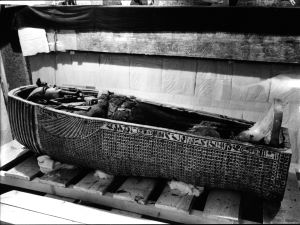
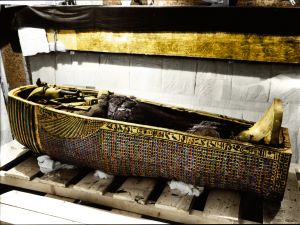
The lid of the innermost coffin revealed
24 October 1925 | Tutankhamun's Tomb
Howard Carter's journal entry describes his examination of Tutankhamun's innermost coffin lid (Carter no. 255), noting, "the first part of this morning was occupied by [Harry] Burton making photographic records of the third coffin. [After] these photographic records were made, [I was then] able to remove the linen covering and inspect for the first time the coffin itself ... it disclosed an astonishing fact - namely that this third coffin is made of solid gold".
Burton photograph 0719b | © Griffith Institute, University of Oxford (colourised by Composite Films)
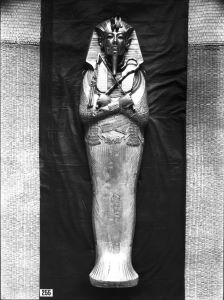
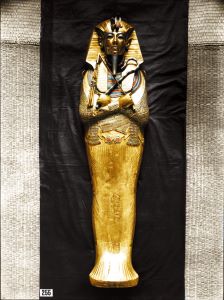
The lid of the innermost gold coffin
Probably shortly after 21 November 1925 | Tutankhamun's Tomb
Tutankhamun's third innermost coffin (Carter no. 255) is pure gold weighing 110 kg. Like all of the King's coffins, it incorporates iconography associated with the god of the dead, Osiris; the ancient Egyptians believed the dead remanifested as the deity. Accordingly, the coffin features the god's tightly bandaged body, with face and hands exposed and wearing a ceremonial beard. Tutankhamun wears the nemes headdress, and his divine sovereignty is symbolised by the vulture and cobra insignia on his forehead and the crook and flail held in his hands.
Burton photograph 0719c1 | © Griffith Institute, University of Oxford (colourised by Composite Films)
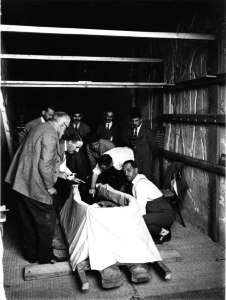
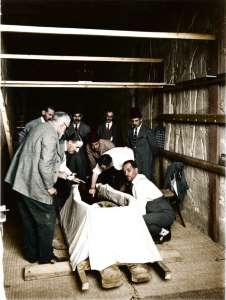
The Tutankhamun Examination Committee
11 November 1925 | Tutankhamun's Tomb
The Tutankhamun Examination Committee watch as Dr Douglas Derry makes the first incision in the wrappings covering Tutankhamun's mummified body. Derry is assisted by his colleague Dr Saleh Bey Hamdi (on his right), while Pierre Lacau (left), Howard Carter (second left) and others look on.
Burton photograph 0939 | © Griffith Institute, University of Oxford (colourised by Composite Films)
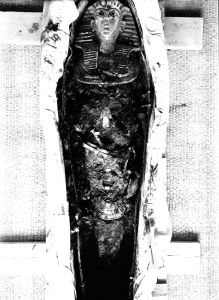
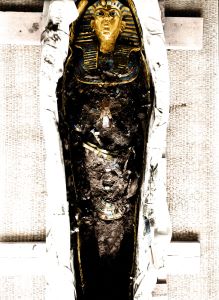
The autopsy of Tutankhamun
12 November 1925 | Tutankhamun's Tomb
The examination and autopsy of Tutankhamun's body occurred over nine days in November 1925. The linen used to wrap the King's body was carbonised and reduced to powder. The examination committee removed the powdery remains of the cloth, to reveal the King's body protected by multiple layers of symbolic jewellery and ritual objects. Harry Burton took a series of photographs before and after each layer of items was lifted away. The photograph documents a falcon collar covering Tutankhamun's chest and a ceremonial dagger at his waist. The famous gold mask is in place over the King's head and upper chest.
Burton photograph 0780 | © Griffith Institute, University of Oxford (colourised by Composite Films)
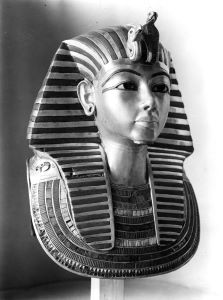
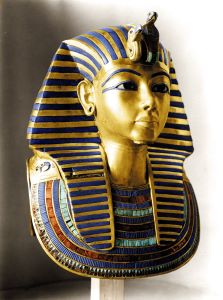
Tutankhamun's mask
Between 16 and 31 December 1925 | Tutankhamun's Tomb
Placed over the head of Tutankhamun's wrapped body, the gold mask is the most iconic object from the tomb. Harry Burton's photograph of the mask, its surfaces dulled by a layer of wax, is supported on a wooden stand. Howard Carter described the King's face as bearing a "sad but tranquil expression", commenting later that it was "suggestive of youth overtaken prematurely by death".
Burton photograph 1545 | © Griffith Institute, University of Oxford (colourised by Composite Films)
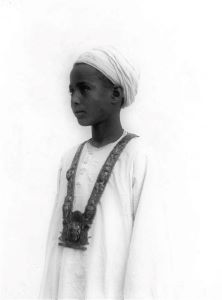
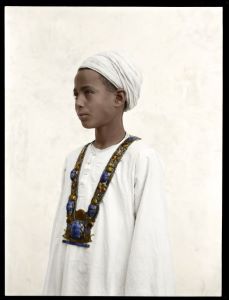
An Egyptian boy wearing one of Tutankhamun's pectorals (1)
Late 1926 or early 1927 | Tutankhamun's Tomb
An Egyptian boy wearing one of Tutankhamun's pectorals (Carter no. 267g-h) from a box found in the so-called Treasury in the king's tomb. Many years later, Hussain Abd el-Rassul identified himself as the boy in the photograph. This image is one of a sequence of photos Harry Burton took of the boy wearing the same pectoral (see following)
Burton photograph 1189 | © Griffith Institute, University of Oxford (colourised by Composite Films)
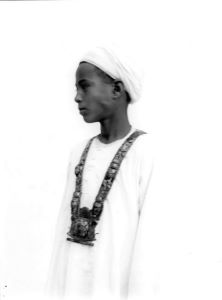
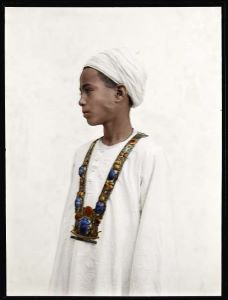
An Egyptian boy wearing one of Tutankhamun's pectorals (2)
Late 1926 or early 1927 | Tutankhamun's Tomb
An Egyptian boy wearing one of Tutankhamun's pectorals (Carter no. 267g-h) from a box found in the so-called Treasury in the king's tomb. Many years later, Hussain Abd el-Rassul identified himself as the boy in the photograph. This image is one of a sequence of photos Harry Burton took of the boy wearing the same pectoral (see following)
Burton photograph 1190 | © Griffith Institute, University of Oxford (colourised by Composite Films)
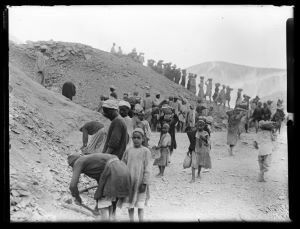
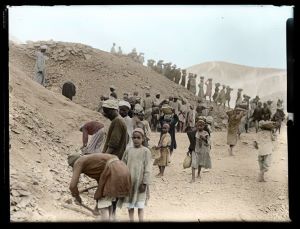
Carter-Carnarvon excavations in the Valley of the Kings, 1920
January 1920 | Valley of the Kings
Taken by Howard Carter during the third season of the Carnarvon-Carter excavations in the Valley of the Kings, this image captures the Egyptian workforce, which, shockingly for modern audiences, includes children. They are clearing an area between the tombs of Ramesses IV (KV 2) and Ramesses II (KV 7) and, unknowingly, are gradually working in the direction of the entrance to Tutankhamun's tomb, still concealed under several metres of debris.
Burton photograph kv40 | © Griffith Institute, University of Oxford (colourised by Composite Films)
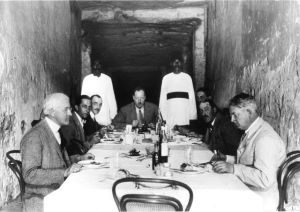
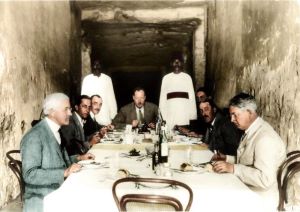
Lunch in the tomb
16 February 1923 | Valley of the Kings
Lunch in the tomb of Ramesses XI (KV 4), this photograph was taken by Lord Carnarvon, whose seat at the head of the table (near front) is unoccupied. The diners are (left to right) James Henry Breasted, Harry Burton, Alfred Lucas, Arthur Callender, Arthur Mace, Howard Carter and Alan Gardiner.
Burton photograph 1544 | © Griffith Institute, University of Oxford (colourised by Composite Films)
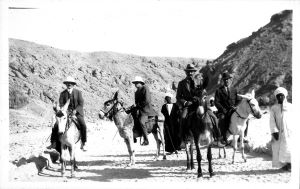
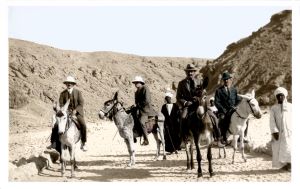
The excavation team travelling by donkey to the Valley
Probably early 1923 | Valley of the Kings
Travelling by donkeys to the Valley of the Kings was the Tutankhamun excavation team's usual mode of transport since they all stayed in nearby dig houses at Thebes. From left to right are Alfred Lucas, Arthur Callender, Howard Carter and an unidentified man.
TAA Archive ii.6.62 | © Griffith Institute, University of Oxford (colourised by Composite Films)
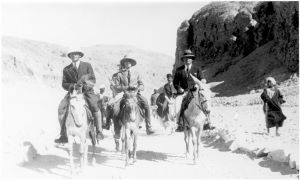
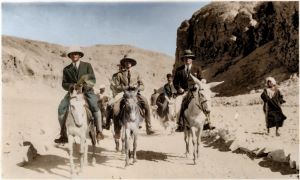
Travelling by donkey to the Valley
Probably early 1923 | Valley of the Kings
Travelling to the Valley of the Kings was a challenge. Most journalists and tourists stayed in Luxor hotels, and to visit the tomb, they first needed to cross the Nile to the West bank by boat. It was then a five-mile journey on unmade roads to reach the Valley, so many journalists and tourists hired donkeys to take them there.
TAA Archive ii.4.47 | © Griffith Institute, University of Oxford (colourised by Composite Films)
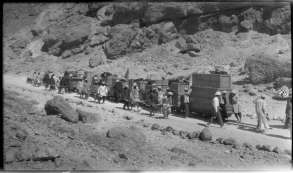
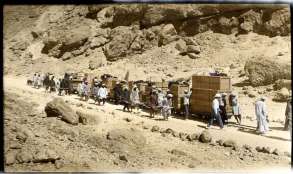
Transporting objects from of the Valley of the Kings
Mid-May 1923 | Valley of the Kings
Moving crates containing objects from Tutankhamun's tomb, using a Decauville railway system, from the Valley of the Kings to the Nile bank. The crates were loaded on a barge destined for Cairo then finally transported to the Egyptian Museum.
Burton photograph kv15 | © Griffith Institute, University of Oxford (colourised by Composite Films)
All © Griffith Institute, University of Oxford (colourised by Dynamichrome, 2022)
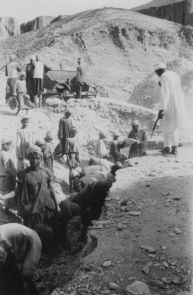
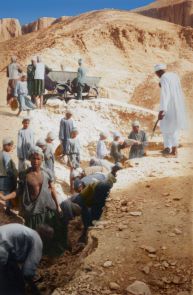
The search for Tutankhamun | Carter-Carnarvon excavations in the Valley of the Kings
19 December 1917 | Valley of the Kings
The search for Tutankhamun’s tomb began in 1917 with an exploratory excavation near the tomb of Merenptah (KV8). What Carter didn’t know when he took this photograph, was that he was working just a few metres away from the location of Tutankhamun’s tomb, which he would discover five years later.
Carter MSS i.J.360 | © Griffith Institute, University of Oxford (colourised by Dynamichrome)

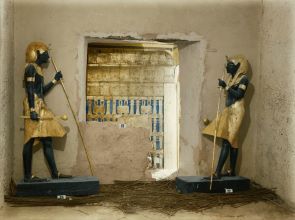
Tutankhamun's "guardian statues"
Probably February 1923 | Tutankhamun's Tomb
The two ka statues of Tutankhamun (Carter nos. 22 and 29), often referred to as the "guardian statues", stand sentinel on either side of the Burial chamber's doorway (Carter no. 28), with some of the door's blocking still in place.
Burton photograph p0292 | © Griffith Institute, University of Oxford (colourised by Dynamichrome)
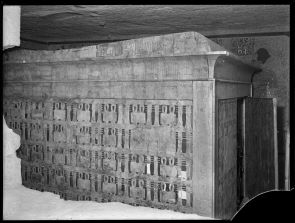
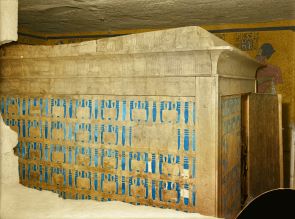
"A wall of gold and blue"
16 or 17 February 1924 | Tutankhamun's Tomb
Harry Burton's photograph, taken from the Antechamber through the entrance into the Burial chamber, records Tutankhamun's blue and gold outermost burial shrine (Carter no. 207) that almost entirely filled the room.
Burton photograph p0604 | © Griffith Institute, University of Oxford (colourised by Dynamichrome)

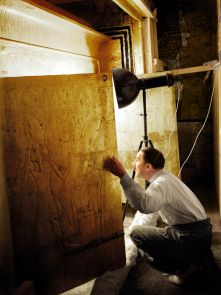
Howard Carter opening the burial shrine door
January 1924 | Tutankhamun's Tomb
Howard Carter opening the door of the second burial shrine (Carter no. 237), in Tutankhamun's Burial chamber.
Burton photograph 0626 | © Griffith Institute, University of Oxford (colourised by Dynamichrome)

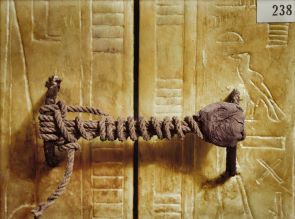
The unbroken seal
3 January 1924 | Tutankhamun's Tomb
Harry Burton's photograph records the intact necropolis seal and cord fastening (Carter no. 238a) on the third (of four) great gilded shrines surrounding Tutankhamun's sarcophagus in the Burial chamber. The unbroken seal confirmed that the King's body remained undisturbed, despite the tomb having been broken into and robbed several times in antiquity.
Burton photograph p0631 | © Griffith Institute, University of Oxford (colourised by Dynamichrome)
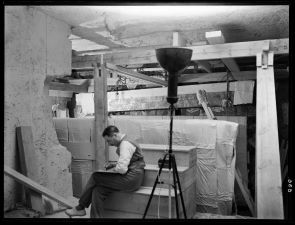
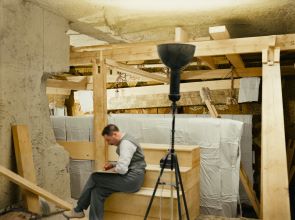
Howard Carter recording in Tutankhamun's tomb
Between 10 and 12 February 1924 | Tutankhamun's Tomb
Harry Burton's apparently informal portrait of Howard Carter, captures the archeologist sitting at the entrance to the Burial chamber, taking advantage of a quiet moment in the proceedings to make notes. Behind him are the wrapped panels of the burial shrines, dismantled in preparation for the lifting of the sarcophagus lid, which took place on 12 February 1924.
Burton photograph p0636 | © Griffith Institute, University of Oxford (colourised by Dynamichrome)

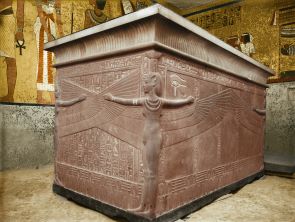
The sarcophagus
Mid-January 1933 | Tutankhamun's Tomb
A general view of Tutankhamun's sarcophagus (Carter no. 240) shows Isis, one of the four protective goddesses, carved in high relief on one of its corners. The goddesses' winged arms are stretched out to embrace the King. Harry Burton's photographs of the sarcophagus were the final excavation records made in the tomb.
Burton photograph 0646f | © Griffith Institute, University of Oxford (colourised by Dynamichrome)
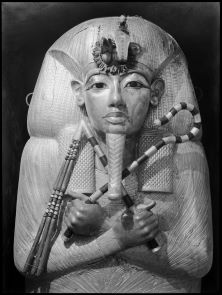
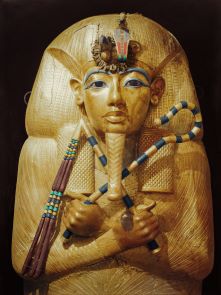
Tutankhamun's outer coffin
5 February 1925 | Tutankhamun's Tomb
Harry Burton's photograph of the upper part of Tutankhamun's outer (first) coffin lid (Carter no. 253), which depicts the King manifested as the god of the dead, Osiris. The coffin features the god's body tightly wrapped in bandages, with face and hands exposed and a ceremonial beard. Evidence of Tutankhamun's divine sovereignty is also apparent: the vulture and cobra insignia on his forehead and the crook and flail held in his hands. The insignia comprises the animal forms of the two goddesses of Upper and Lower Egypt, and the vulture represents Nekhbet and the cobra Wadjet. Encircling the insignia is a tiny garland of cornflowers, lotus petals and olive leaves.
Burton photograph 0658 | © Griffith Institute, University of Oxford (colourised by Dynamichrome)

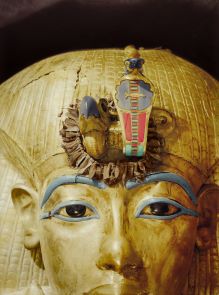
A tiny garland on the coffin's head
5 February 1925 | Tutankhamun's Tomb
A garland on the royal insignia of cobra and vulture on the forehead of Tutankhamun's outer coffin (Carter no. 253), as found in the King's Burial chamber.
Burton photograph 0709 | © Griffith Institute, University of Oxford (colourised by Dynamichrome)
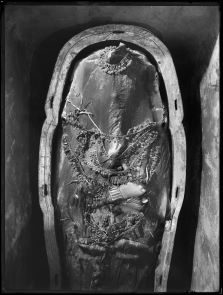
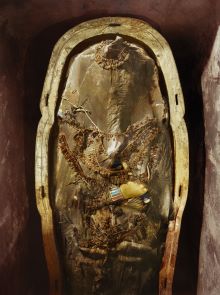
Tutankhamun's veiled middle coffin
17 October 1925 | Tutankhamun's Tomb
Howard Carter's entry in his excavation journal mentions Harry Burton taking photographs of the lid of Tutankhamun's middle coffin (Carter no. 255), commenting "early this morning Burton completed successfully the photographic records of the second coffin, covered with its shroud and floral garlands, as it rested in situ in the shell of the outermost coffin".
Burton photograph 0718 | © Griffith Institute, University of Oxford (colourised by Dynamichrome)
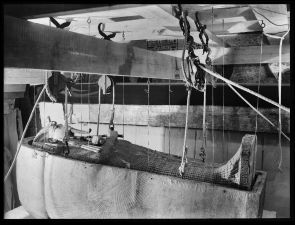
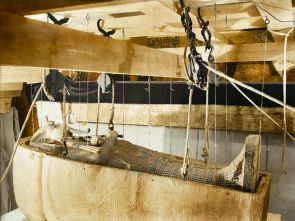
Removing Tutankhamun's middle coffin from the outer coffin
22 or 23 October 1925 | Tutankhamun's Tomb
Harry Burton's photograph records the equipment in place and ready for the delicate stage of removing the middle coffin from the lower part of the outer coffin. The team attached wire cables to the middle coffin, fixing these to the overhead scaffold, and then screwed strong metal eyelets into the top edge of the outer coffin's lower portion. After removing the planks laid on top of the sarcophagus beneath the coffins, they lowered the outer coffin case back down into the sarcophagus, freeing it from the middle coffin, now suspended on cables. The team quickly lowered the second coffin onto a wooden tray, wide enough to span the sarcophagus.
Burton photograph 0725 | © Griffith Institute, University of Oxford (colourised by Dynamichrome)
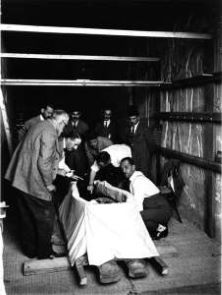
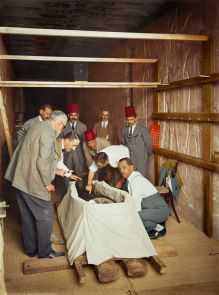
The Tutankhamun Examination Committee
11 November 1925 | Tutankhamun's Tomb
The Tutankhamun Examination Committee watch as Dr Douglas Derry makes the first incision in the wrappings covering Tutankhamun's mummified body. Derry is assisted by his colleague Dr Saleh Bey Hamdi (on his right), while Pierre Lacau (left), Howard Carter (second left) and others look on.
Burton photograph 0939 | © Griffith Institute, University of Oxford (colourised by Dynamichrome)
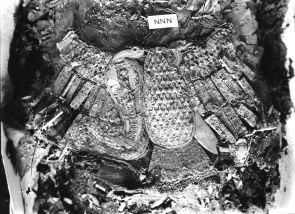
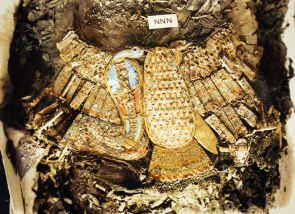
Tutankhamun's inlaid collar
15 November 1925 | Tutankhamun's Tomb
During the unwrapping and examination of Tutankhamun's body, which took place between 11 and 19 November 1925, Howard Carter discovered over 150 amulets and other objects inside the layers of bandages. This ritually protective collar portrays the Nebty, meaning the "Two Ladies", and represents the Upper and Lower Egypt goddesses in their animal form: Nekhbet, the vulture and Wadjet, the cobra. This colourful collar comprises over 160 gold and coloured glass cloisonné-work plaques forming the goddesses' bodies and the individual feathers of the wings.
Burton photograph 0798 | © Griffith Institute, University of Oxford (colourised by Dynamichrome)
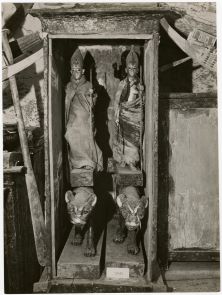
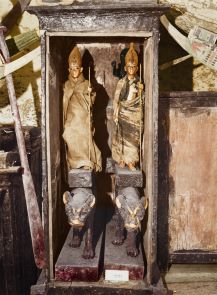
Two Tutankhamun statues wrapped in linen
late October or early November 1926 | Tutankhamun's Tomb
The so-called Treasury was the third room to be recorded and cleared by Howard Carter and his team, and within this room was a stack of small black shrines containing statues of the King and deities. The doors of one of these shrines were found open, the contents left untouched by the robbers who had entered the tomb in antiquity and were looking for high-value items. The shrine contained a pair of gilded wood statuette groups portraying Tutankhamun standing on the back of a panther. The King wears the crown of Upper Egypt, holds a staff and wears a linen cloak-like wrapping, which was not just packing material but also a ritual covering.
Burton photograph 1010b | © Griffith Institute, University of Oxford (colourised by Dynamichrome)
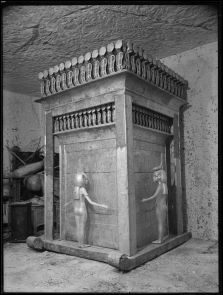
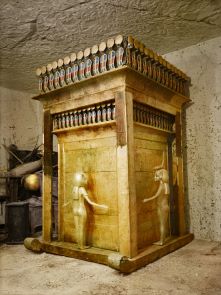
Tutankhamun's canopic shrine
probably 8 April 1927 | Tutankhamun's Tomb
To the east of the Burial chamber was a storeroom Howard Carter named the 'Treasury'. At the back of this room stood a tall, gilded canopic shrine that housed Tutankhamun's embalmed internal organs. Arthur Mace thought it was 'the most impressive monument I've ever seen - a huge wooden shrine covered with gold to contain the canopic jars, and full standing guarding it one on each side there were four goddesses, the most lovely female figures, absolutely natural and lifelike in their poise, one with back turned and two looking sideways over their shoulders.'
Burton photograph 1144 | © Griffith Institute, University of Oxford (colourised by Dynamichrome)
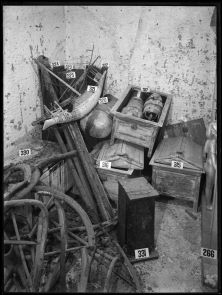
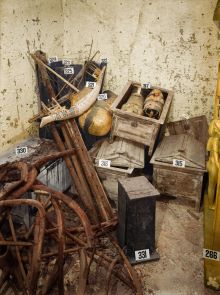
Objects in situ in the Treasury
November 1926 | Tutankhamun's Tomb
To the east of the Burial chamber was a storeroom Howard Carter named the 'Treasury'. At the back of this room stood a tall, gilded canopic shrine that housed Tutankhamun's embalmed internal organs. Arthur Mace thought it was 'the most impressive monument I've ever seen - a huge wooden shrine covered with gold to contain the canopic jars, and full standing guarding it one on each side there were four goddesses, the most lovely female figures, absolutely natural and lifelike in their poise, one with back turned and two looking sideways over their shoulders.'
Burton photograph 1170 | © Griffith Institute, University of Oxford (colourised by Dynamichrome)
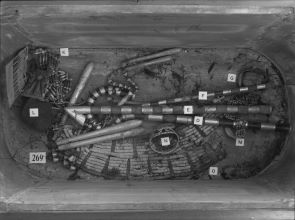
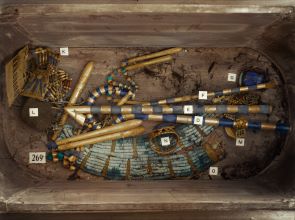
Tutankhamun's jewellery and regalia
late November 1926 | Tutankhamun's Tomb
Harry Burton's photograph shows the interior of the cartouche-shaped box (Carter 269) from the Treasury, which contained gold bracelets, several pairs of earrings and other jewellery. The box also held a unique discovery, the crook and flail, symbols of the king's royal and divine power. These are child-sized and held by Tutankhamun during official appearances.
Burton photograph 1182 | © Griffith Institute, University of Oxford (colourised by Dynamichrome)

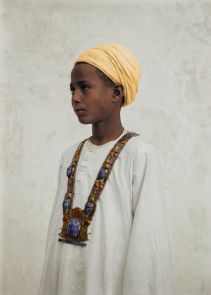
An Egyptian boy wearing one of Tutankhamun's pectorals
Late 1926 or early 1927 | Tutankhamun's Tomb
An Egyptian boy wearing one of Tutankhamun's pectorals (Carter no. 267g-h) from a box found in the so-called Treasury in the king's tomb. Many years later, Hussain Abd el-Rassul identified himself as the boy in the photograph. This image is one of a sequence of photos Harry Burton took of the boy wearing the same pectoral (see following)
Burton photograph 1189 | © Griffith Institute, University of Oxford (colourised by Dynamichrome)

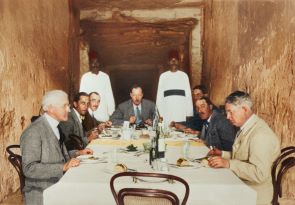
Lunch in the tomb
16 February 1923 | Valley of the Kings
Lunch in the tomb of Ramesses XI (KV 4), this photograph was taken by Lord Carnarvon, whose seat at the head of the table (near front) is unoccupied. The diners are (left to right) James Henry Breasted, Harry Burton, Alfred Lucas, Arthur Callender, Arthur Mace, Howard Carter and Alan Gardiner.
Burton photograph 1544 | © Griffith Institute, University of Oxford (colourised by Dynamichrome)
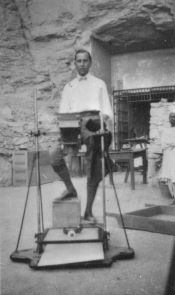
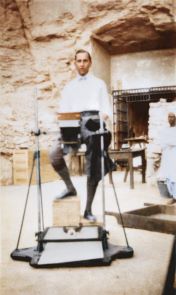
The excavation photographer | Harry Burton
probably February 1923 | Tutankhamun's Tomb
Harry Burton's images of Tutankhamun's tomb and its objects are iconic. This photograph, taken by a photographer working for 'The Times' newspaper, shows Burton posing with his camera equipment. The photographic 'studio' was outside in the Valley in front of the tomb of Seti II (KV15), which served as the excavation's conservation laboratory. Another tomb nearby (KV55) was used as a dark room.
TAA ii.19.14.1.3 | © Griffith Institute, University of Oxford (colourised by Dynamichrome)
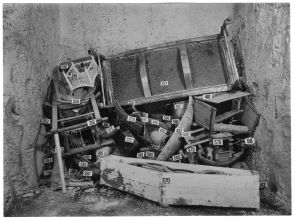
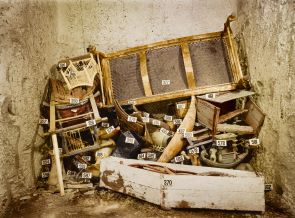
A packed storeroom | the Annexe
early December 1927 | Tutankhamun's Tomb
The last tomb to be cleared by the excavation team was a small storeroom (the Annexe) leading off from the west wall of the Antechamber, which Howard Carter described as being 'so packed one cannot see really what is there', and a 'witness of the neglect and dishonour that the royal tomb suffered'. The disarray made the clearance difficult for the team, who had to work suspended in a sling over the objects. Burton's photograph records the southern side of the chamber, already partially cleared and with the items numbered. The large triangular white box (Carter no. 370) was for Tutankhamun's bows, arrows, throw sticks and clubs. The jumbled mass behind includes baskets, pots, decorative vessels (e.g. no. 579) and model boats (e.g. no. 437); on the top is an upturned bed (no. 377) and an upside-down white, child-sized throne (no. 349).
Burton photograph 1689 | © Griffith Institute, University of Oxford (colourised by Dynamichrome)

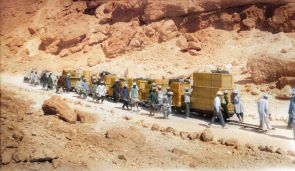
Transporting objects from the Valley of the Kings (1)
Mid-May 1923 | Valley of the Kings
Moving crates containing objects from Tutankhamun's tomb, using a Decauville railway system, from the Valley of the Kings to the Nile bank. The crates were loaded on a barge destined for Cairo then finally transported to the Egyptian Museum.
Burton photograph kv15 | © Griffith Institute, University of Oxford (colourised by Dynamichrome)
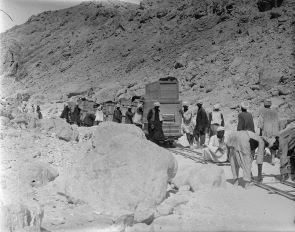
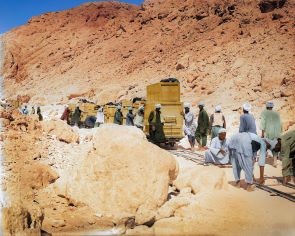
Transporting objects from the Valley of the Kings (2)
Mid-May 1923 | Valley of the Kings
Moving crates containing objects from Tutankhamun's tomb, using a Decauville railway system, from the Valley of the Kings to the Nile bank. The crates were loaded on a barge destined for Cairo then finally transported to the Egyptian Museum.
Burton photograph kv16 | © Griffith Institute, University of Oxford (colourised by Dynamichrome)

